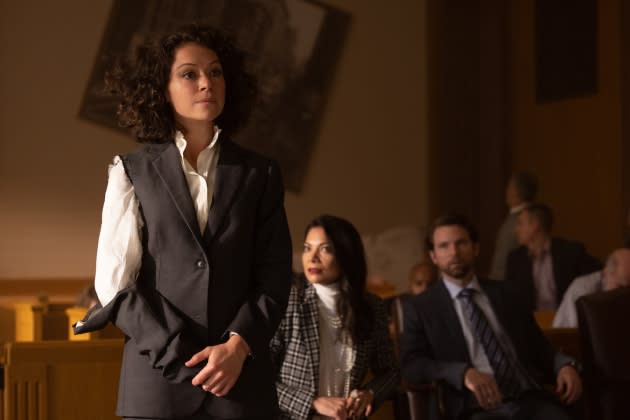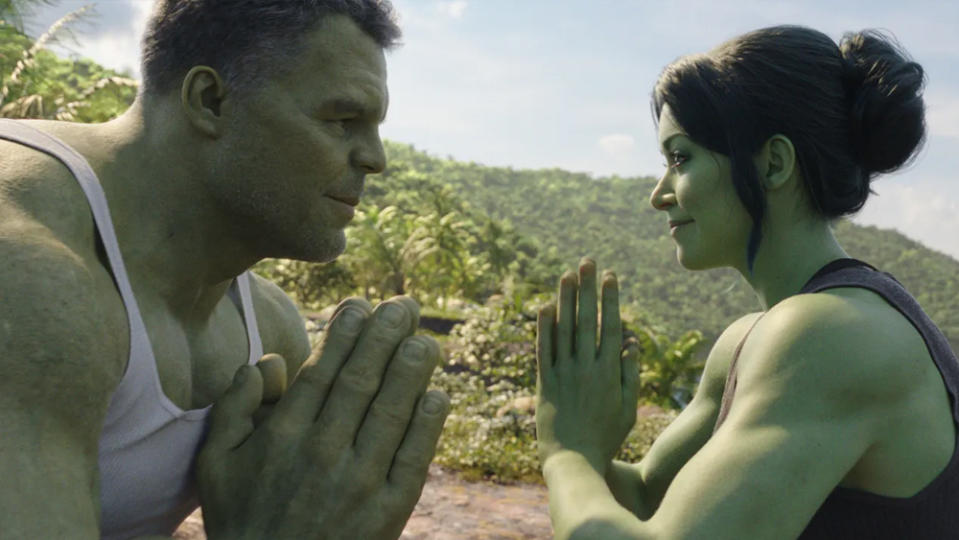‘She-Hulk’ Star Tatiana Maslany Reveals the Scene She Couldn’t Get Through and Her ‘Seinfeld’ Inspiration
- Oops!Something went wrong.Please try again later.
- Oops!Something went wrong.Please try again later.

Tatiana Maslany knows from playing multiple roles on the same TV series. From 2013 to 2017, she embodied over a dozen clones on the sci-fi series “Orphan Black,” and won an Emmy for it in the process.
On the new Marvel Studios series “She-Hulk: Attorney at Large,” however, Maslany tackled a new challenge: Transforming from the capable-if-neurotic Los Angeles lawyer Jennifer Walters into her green, six-foot-seven alter-ego known as She-Hulk. Maslany worked with director and executive producer Kat Coiro, creator and head writer Jessica Gao, and fellow Hulk and co-star Mark Ruffalo (who plays Jennifer’s cousin, Bruce Banner) to bring She-Hulk to life. She talked with Variety about the technical challenges of the show, the scene she could barely get through, and why her biggest inspirations were “Legally Blonde” and “Seinfeld.”
More from Variety
What was the pitch to you about this role in the show?
The pitch was basically the pilot script that I read when I got the audition. What struck me about it was that it was just so unexpected. It was so funny on every page, and it was super weird. It just felt very specific and very anti-MCU largeness in a way that I was like, oh my god, this is so much fun, and I absolutely would die to play this part.
When Mark Ruffalo has played the Hulk, he’s worn a gray motion capture suit and a static Hulk head over his actual head. Did you do something similar for She-Hulk?
Yeah. In all those scenes where we look great on camera, we’re actually both just in gray PJs with helmets on our heads and these cameras in front of our faces. Sometimes you’re walking on a platform, if you’re working with an actor who’s not also a Hulk, so that their eyeline is actually looking up at where your face would be. Or, alternatively, you’ve got this stick on your helmet that has like a frozen She-Hulk smiling face, and they’re talking to that. So really, as much as it’s a burden to be wearing this stuff for myself as an actor, I think it’s harder for my scene partner, because they’re having to imbue life into this cardboard face.
Well, you get to see both sides, since you’re playing human Jennifer talking to Smart Hulk.
I think I totally forgot I did that. I completely forgot that there was one scene where we were in the lab, and Mark had that face on and I was having to talk to it and I couldn’t stop — I was laughing the whole time. Like, the whole scene, is me shaking. I couldn’t do it, because it is really destabilizing.
This process is called performance capture, but was there concern for you that there’d be something lost between the performance you’re giving and what we end up seeing on screen?
I’ve witnessed over time — I think we all have as cinema-goers — this incredible nuance that has become part of a CG character. But yeah, I had questions around how much of my thought or my nuances as an actor would translate, just human behaviors that take you out of an uncanny valley thing to put you deeply in the reality of the show. I saw tests that they did of She-Hulk pretty early in production. And yeah, I trusted it. I actually see her breathing. I see her fidgeting in a way that only a human actor would fidget. I see her thinking. And so it really assuaged any subtle fear that I would have had about that.

Marvel Studios
Jennifer obviously notices a difference in how people treat her as She-Hulk in the show. Did you notice a difference as an actor between when you were playing Jennifer and when you were playing She-Hulk?
Yeah. Mark and I definitely talked about the feeling of being in the suit versus you know, otherwise. I’m able to connect much easier if I don’t have a camera in front of my face with my scene partner. But then as soon as I am She-Hulk and I’m in this costume, that does kind of separate me from people — puts me on platforms so I take up a different space. All of that stuff, to me, informs how the character feels. I feel like I’m taking up this entire room because this platform that I’m walking on is inhibiting other actors from doing whatever they want. So inherently, I’m owning the space in a different way. There’s all those things that suggest to you as an actor truth about your character that’s actually really fun to embody.
You, of course, had to navigate a lot of tricky visual effects on “Orphan Black” with all of the doubling you had to do. What was the biggest learning curve for you with this show, given your past experience?
I feel like that set me up very well to step into something so technical and do it with an awareness that it can be actually very liberating. What’s different about this is that sometimes I’m in a volume where there’s no set, there’s no costume, there’s sometimes no other scene partners. Everything is created. And something about that, actually — and I’m sure other actors have said this — taps into this thing that you do in a theater rehearsal, where you’re imagining that might be where the bed is, or you’re imagining the fourth wall or whatever. There’s all these things you create as an actor to make it real. This [show] actually lends itself more to that kind of acting than some film acting does. There’s a little more imagination work, which is actually like a kind of playful child place to play from.
“Ally McBeal” has been referenced a lot in describing this show, and it even plays on a bar where Jennifer is getting a drink. Did you look at that show as a tonal inspiration for what you’re doing?
Um, tonally for me, I haven’t ever seen an episode of “Ally McBeal,” I’m sorry to say. But! I did watch “Legally Blonde.” That felt in line somehow to me. Elle Woods is perceived a certain way and always fighting to be seen for who she really is, and also fighting to know herself for who she really is. She’s also a lawyer. She’s also a woman. All of that stuff. But I feel like Elaine Benes [from “Seinfeld”] was more of a touchstone to me. Just in terms of, she’s obviously an incredibly capable person, but she also gets in her own way and has hang ups or rigidities that make her a mess. I also just love Elaine. She was who I grew up watching.
You’re directly addressing the camera a fair amount on this show. What was that like for you to play?
It was daunting initially, because I’ve seen it done so many times so well by like incredibly skilled actors. You know, Phoebe Waller-Bridge [on “Fleabag”], in “Ferris Bueller,” all of these really iconic performances. What kept me feeling like what we were doing was specific and different was just “She-Hulk” has always been meta. The comics were incredibly meta. She’s always talking to the audience or to the writer. And there’s something about her awareness that maintains from her Jen form to She-Hulk, where she has this hyper awareness — it is part of her superpower — that also is now part of her connection to the audience. She’s aware of the system within which she operates. She’s aware of all the mechanics of it, and engages with that. And that feels relevant to me in terms of being a woman and knowing your place and your space in every room. There’s something about it that that felt very vital to me.
This interview has been edited and condensed.
Best of Variety
From 'The Sandman' to 'Blonde': Books Made Into Movies and TV Series That You Should Read
Jennette McCurdy's Provocative Book 'I'm Glad My Mom Died' Is Already a No. 1 Bestseller
Sign up for Variety’s Newsletter. For the latest news, follow us on Facebook, Twitter, and Instagram.

